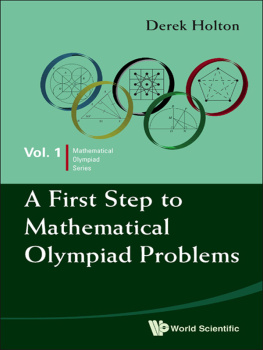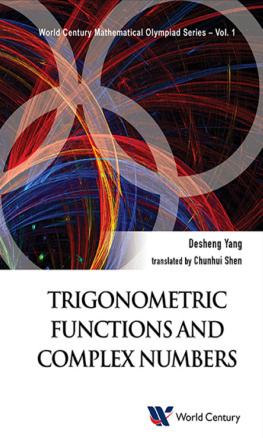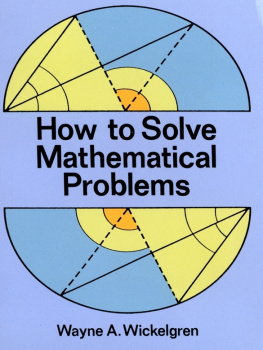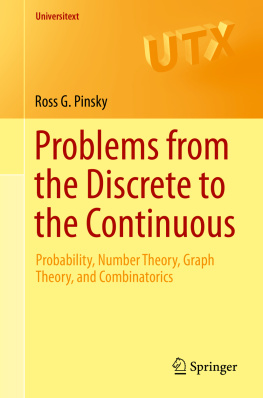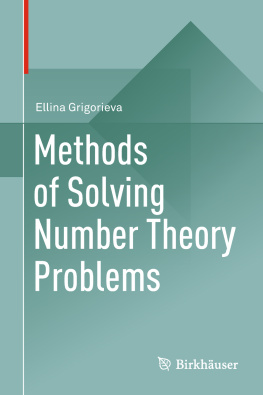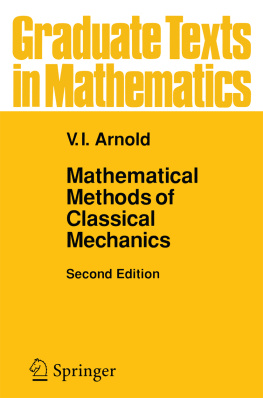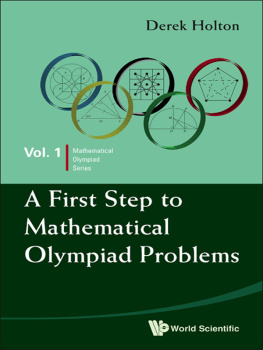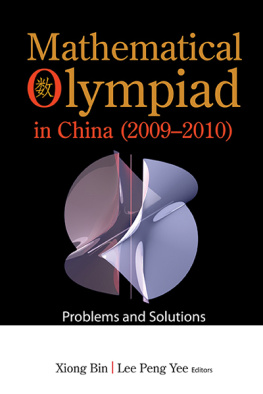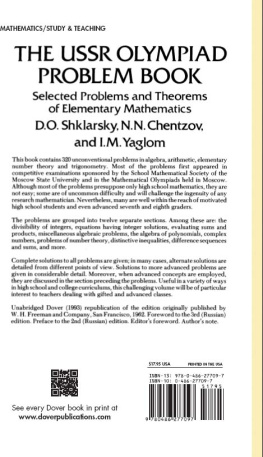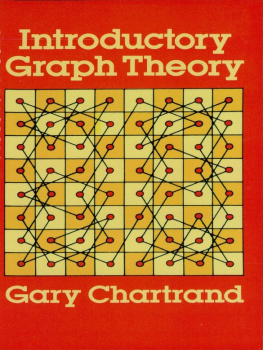Derek Holton
University of Otago, New Zealand

A First Step to
Mathematical
Olympiad Problems

NEW JERSEY LONDON SINGAPORE BEIJING SHANGHAI HONG KONG TAIPEI CHENNAI
Published by
World Scientific Publishing Co. Pte. Ltd.
5 Toh Tuck Link, Singapore 596224
USA office: 27 Warren Street, Suite 401-402, Hackensack, NJ 07601
UK office: 57 Shelton Street, Covent Garden, London WC2H 9HE
British Library Cataloguing-in-Publication Data
A catalogue record for this book is available from the British Library.
A FIRST STEP TO MATHEMATICAL OLYMPIAD PROBLEMS Mathematical Olympiad Series Vol. 1
Copyright 2010 by World Scientific Publishing Co. Pte. Ltd.
All rights reserved. This book, or parts thereof, may not be reproduced in any form or by any means, electronic or mechanical, including photocopying, recording or any information storage and retrieval system now known or to be invented, without written permission from the Publisher.
For photocopying of material in this volume, please pay a copying fee through the Copyright Clearance Center, Inc., 222 Rosewood Drive, Danvers, MA 01923, USA. In this case permission to photocopy is not required from the publisher.
ISBN-13 978-981-4273-87-9
(pbk) ISBN-10 981-4273-87-2 (pbk)
Typeset by Stallion Press
Email:
Printed in Singapore.
To Marilyn, for all her help and encouragement
Foreword
The material in this book was first written for students in New Zealand who were preparing to compete for the six positions in New Zealand's International Mathematical Olympiad (IMO) team. At that stage there was very little mathematical writing available for students who were good at high school mathematics but not yet competent to tackle IMO problems. The aim of the material here then was to give those students sufficient background in areas of mathematics that are commonly the subject of IMO questions so that they were ready for IMO standard work.
This book covers discrete mathematics, number theory and geometry with a final chapter on some IMO problems.
So this book can provide a basis for the initial training of potential IMO students, either with students in a group or for students by themselves. However, I take the approach that solving problems is what mathematics is all about and my second aim is to introduce the reader to what I believe is the essence of mathematics. In many classrooms in many countries, mathematics is presented as a collection of techniques that have to be learnt, often just to be reproduced in examinations. Here I try to present the other, creative, side of the mathematical coin. This is a side that I believe to be far more interesting and exciting. It is also the side that enables students to get some idea of the way that research mathematicians approach their work.
So this book can be used to start students on the trail towards the IMO but its broader aim is to start students on a trail to understanding what mathematics really is and then possibly to taking that understanding and using it in later life, both inside mathematics and outside it.
I would like to thank Irene Goodwin, Leanne Kirk, Lenette Grant, Lee Peng Yee and Zhang Ji for all of their assistance in the preparation of this book.
Chapter 1
Jugs and Stamps: How To Solve Problems
1.1. Introduction
In this chapter I look at some number problems associated with jugs, consecutive numbers and stamps. I extend and develop these problems in the way that a research mathematician might. At the same time as this is being done, I develop skills of problem solving and introduce some basic mathematical theory, especially about a basic fact of relatively prime numbers.
Whether you are reading this book as a prelude to IMO training or out of interest and curiosity, you should know from the start that mathematics is all about solving problems. Hence the book concentrates on problem solving. Now a problem is only something that, at first sight, you have no idea how to solve. This doesn't mean that a problem is a problem for everyone. Indeed, after you have solved it, it isn't a problem for you any more either. But what I am trying to do here is to both introduce you to some new mathematics and at the same time show you how to tackle a problem that you have no idea at first how to solve.
This book tackles areas of mathematics that are usually not covered in most regular school syllabuses. Sometimes some background is required before getting started but the goal is to show how mathematics is created and how mathematicians solve problems. In the process I hope you, the reader, get a great deal of pleasure out of the work involved in this book.
I have tried to design the material so that it can be worked through by individuals in the privacy of their own brains. But mathematics, like other human pursuits is more fun when engaged in by a group. So let me encourage you to rope in a friend or two to work with you. Friends are also good for talking to about mathematics even if they know nothing about the subject. It's amazing how answers to problems appear when you say your problem out loud.
Now I expect the geniuses amongst you will be able to work through all this book from cover to cover without a break. The mere mortals, however, will most likely read, get stuck somewhere, put the book down (or throw it away) and hopefully go back to it later. Sometimes you'll skim over a difficulty and go back later (maybe much later). But I hope that you will all get some enjoyment out of solving the problems here.
1.2. A Drinking Problem
No problem solving can be done without a problem, so here is the first of many.
Problem 1.Given a 3 litre jug and a 5 litre jug can I measure exactly 7 litres of water?
Discussion. You've probably seen this question or one like it before but even if you haven't you can most likely solve it very quickly. Being older and more senile than most of you, bear with me while I slog through it.
I can't see how to get 7. So I'll doodle a while. Hmm. I can make 3, 6 or 9 litres just using the 3 litre jug and 5, 10 or 15 litres with the 5 litre jug. It's obvious, from those calculations that I'm going to have to use both jugs.
Well, it's also pretty clear that 7 3a + 56 if I keep a and b positive or zero. So I can't get 7 by just adding water from the two jugs in some combination. So what if I pour water from one jug into another?
Let's fill up the 3 litre jug, then pour the water into the 5 litre jug. I can then fill up the 3 litre jug and pour into the bigger jug again until it's full. That leaves 1 litre in the 3 litre jug. Now if I drink the 5 litres of water from the larger jug I could pour 1 litre of water into some container.

